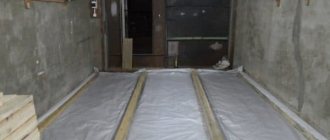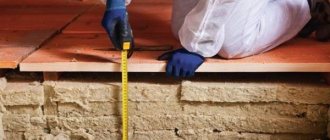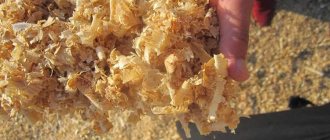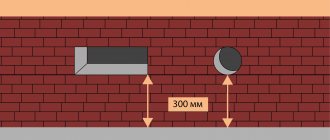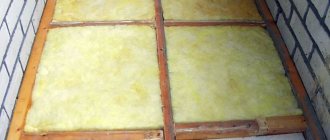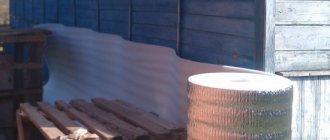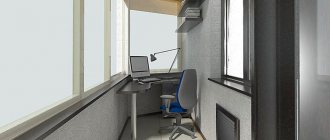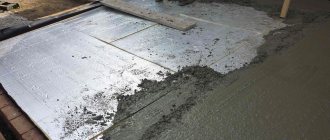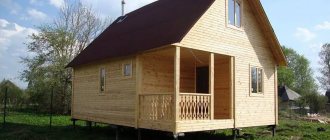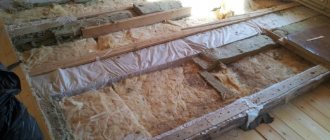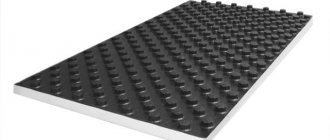One of the most serious problems of living in a country house, especially if it is made of wood, is a cold floor. Insulating the floor in a wooden house from below, which is done using different materials and different technologies, will ensure comfortable and cozy living. More information about insulating a house made of wood will be discussed in this article.
Insulation of the floor from below in a wooden house
A few words about thermal insulation
Drafts in combination with a cool floor do not bring positive emotions, and they also have a bad effect on health. Therefore, there is no point in arguing about the need for thermal insulation in the house. Insulating the floor below is a mandatory and inevitable event, which will pay off all costs over time.
Insulation of a wooden house
The thermal insulation process can be divided into several stages:
- dismantling the floor covering;
- installation of subfloor;
- laying a layer of thermal insulation;
- laying vapor barrier;
- installation of finished floor.
Floor insulation scheme on the first floor
Advantages of a wooden floor
A similar scheme is suitable for cases where a wooden house is being restored during renovation. But if a house is being built from scratch, then all of the above steps are performed during the construction stage.
Thermal insulation of the floor in a wooden house
When insulation is required from below
There are several main reasons why a wooden house is thermally insulated from below. These include:
When is floor insulation required in a home?
- the need to reduce the height of the room;
- protection of the floor and the entire covering from freezing;
- moving the dew point, thereby avoiding the process of rotting.
Insulation of floors protects the house from freezing
During renovation work in a private house, some difficulties often arise that are directly related to the insulation of the bottom. Let's look at the most common of them:
- more reliable fixation of the heat-insulating material is required;
- the presence of a low subfloor greatly complicates the work;
- insulation of the floor from below contributes to rapid fatigue of workers, which greatly delays the process;
- The variety of types of insulation is not very large.
How and with what you can insulate the floor in a private house
Floor insulation is a rather complex process that requires preparation. First of all, before starting repair work, you need to decide on the choice of insulation.
How can you insulate the floor in a private house and what materials should you use?
Material selection
There are several main criteria by which you should choose insulation. These include:
Materials for floor insulation in the house
- resistance to rodents and high humidity;
- durability of the material;
- complexity of installation;
- financial capabilities of the home owner (some materials are not cheap).
Floor insulation with foam plastic
Note! When insulating the floor in a country house, where the owners rarely visit, it is important to choose materials that are resistant to different types of rodents. It is mice, combined with high humidity, that are the main reasons for the destruction of wooden floors.
What is the best way to insulate the floor in a wooden house?
Table. Overview of wooden floor insulation.
| Name of material, photo | Description |
| Expanded clay | It is a small granule with a porous structure. Expanded clay retains heat well, and small rodents and harmful insects do not live in it. The optimal thickness of the expanded clay layer is 20-30 cm. |
| Styrofoam | A fairly lightweight and easy-to-install material used for insulating houses and apartments. The foam is moisture resistant, but is afraid of rodents, which quickly destroy it. |
| Wood shavings | One of the cheapest insulation materials, which can be purchased without any problems at your nearest wood processing plant. Wood shavings actively retain heat, but are not moisture resistant. |
| Slag | An excellent material for insulating houses. The slag needs waterproofing, which significantly complicates the installation process. But slag is a durable material. |
| Glass wool | An inexpensive heat-insulating material that not only retains heat in the house, but also muffles sounds. Among the disadvantages of glass wool, it is worth highlighting the material’s tendency to shrink over time. |
| Ecowool | Another type of insulation with low thermal conductivity. To install ecowool, a special installation is required, since it is quite difficult to manually blow it into the underground space. |
Thermal insulation materials for floors
Expanded vermiculite can also be used as crumbly floor insulation. This is a natural material with a granular structure. Vermiculite is lightweight and has high heat and sound insulation properties. In addition to construction, vermiculite is actively used in dacha farming.
Vermiculite expanded
Density of insulation
All thermal insulation materials differ from each other not only in composition and production method, but also in the main indicator - density.
| Insulation with an organic base | It is in great demand, made from woodworking and agricultural waste (natural raw materials) with the addition of cement and some types of plastic. It has high fire safety, is not afraid of moisture, and can withstand temperatures up to 150 degrees. |
| Arbolite | In its production, small sawdust, shavings, chopped straw or reeds are used. Chemical additives or cement are used. The manufacturing process ends with treatment with a mineralizer. |
| PPVC (polyvinyl chloride foam) | It contains polyvinyl chloride resins, which acquire a foamy structure during the production process. It can be either hard or soft. Used for insulation of facades, walls, roofs and other surfaces. |
| Chipboard | It is based on small shavings (90% of the total volume) and 10% - synthetic resins and antiseptic substances. |
| DVIP | Identical to chipboard, but straw trimmings, wood waste, and corn stalks are used in production. Synthetic resins with additives of fire retardants, antiseptics, and water-repellent substances are used as a binder. |
| PPU (polyurethane foam) | The composition includes polyester, water, diisocyanate, emulsifier. It has excellent heat-insulating, sound-proofing and moisture-repellent properties. |
| EPP/foam | The composition includes air (98%) and polystyrene (2%). Small amounts of flame retardants are expected. |
| Foamed polyethylene | The porous structure, with good vapor barrier properties, does not conduct noise well. |
| Fibryolite | The composition includes wood shavings, cement or magnesium components. It looks like slabs. Resistant to chemical and biological aggressive influences, moisture resistant, does not allow noise to pass through. |
| Mineral wool | There are two types: stone and slag. Main composition: diabase, dolomite, basalt, limestone, bound by components containing phenol or urea. |
| Glass wool | Glass industry waste is used in production. It has sufficient elasticity and strength, sound insulation, is not afraid of open flames, and does not emit harmful substances at high temperatures. |
| Ceramic wool | The basis is zirconium, aluminum, silicon. Not afraid of high temperatures. |
| Name | Density indicator (kg/m3) |
| Cellulose wool | 30 — 70 |
| Wood-fibre board | 150 230 |
| Foam glass | 100 — 150 |
| Linen mats | 30 |
| Cotton wool | 25 — 30 |
| Mineral wool | 50 — 200 |
| Styrofoam | 25 — 35 |
| Extruded polystyrene foam | 35 — 40 |
| Expanded clay | 450 — 1200 |
| Polyurethane foam | 30 — 80 |
The type of insulation depends on the density. He can be:
The density of the material has a direct impact on indicators such as:
TOP 3 mineral wool manufacturers
| Photo | Name | Rating | Price | |
| #1 | Rockwoll | ⭐ 98 / 100 | More details | |
| #2 | Knauf | ⭐ 97 / 100 | More details | |
| #3 | Isover | ⭐ 96 / 100 | More details |
Rockwoll
The company is considered a market leader in the production of mineral wool. The manufacturer has a wide selection of products.
Rockwoll
pros
- environmental friendliness;
- fire safety;
- soundproofing;
- price-quality ratio;
- long service life;
- no shrinkage or shedding;
- Wide selection of sizes and packaging options.
Minuses
- Personal protective equipment is required when working.
Rockwoll mineral wool
Knauf
Knauf insulation products are safe materials produced using innovative technology and from natural ingredients.
Knauf
pros
- excellent heat and sound insulating properties;
- simple installation;
- non-flammable material;
- without smell;
- resistant to insects and rodents.
Minuses
- high price.
mineral wool Knauf
Isover
The material is supplied in rolls and slabs. The products are manufactured using special technology, which allows them to cope with the assigned tasks perfectly.
Roll insulation ISOVER
pros
- simple installation;
- affordable price;
- a wide range of;
- environmentally friendly material;
Minuses
- low resistance to moisture.
Isover mineral wool
Which insulation is better for walls?
The most suitable material for this type of work is considered to be mineral wool. It has good properties and a long service life. But in order for it to meet your expectations, it is necessary not only to purchase a high-quality product, but also to follow the installation technology, prepare the walls properly, and determine the dimensions and physical characteristics (density and thickness).
The size of mineral wool is determined taking into account the following data:
If you purchase mineral wool with low thermal conductivity, it will not be able to perform its main functions. There is also no need to opt for cheap options packaged in rolls. In their production, as a rule, low-quality components are used. Moreover, the material in rolls is 50mm thick, which is unacceptable for work outside the building. It is advisable to purchase mineral wool slabs of significant size.
The higher the density of the insulation, the heavier it is, and, therefore, more expensive. The density of mineral wool varies from 20 kg/m3 to 250 kg/m3, and therefore there will be a significant difference between the materials. To understand which insulation is best for you, you need to understand what depends on the density:
But the density indicator has no effect on:
Which mineral wool is best for walls
In order not to make a mistake with insulation, it is necessary, first of all, to take into account the climate characteristics in the place of residence. In temperate climates, the recommended insulation thickness should be 80 – 100mm. For continental, sharply continental, sea, monsoon, arctic, subarctic climates, the range of mineral wool can be from 110mm to 150mm.
Insulation with a low density of 40 kg/m3. can only be used on horizontal surfaces that may not withstand significant loads. The minimum density for walls is 50-75 kg/m3. If the facade is supposed to be ventilated, then the density of the insulation should be 110 kg/m3, subject to subsequent finishing with siding. With further plastering of the walls, the density indicator can reach 140 kg/m3.
Thermal insulation methods
Insulation of the floor in a wooden house can be done using two methods - using joists and a rough base. The first method is used to insulate wooden or concrete floors. Any of the above materials can be used as insulation. The entire load is evenly distributed on the surface of the logs, so the strength and density of the material used is not important. When insulating the floor using joists, you should take into account the fact that the height of the room will decrease by about 10 cm due to raising the floor.
Floor insulation methods
The second method requires a more durable and rigid material as insulation to eliminate the possibility of it settling under the influence of loads. The role of the rough foundation can be performed by wooden flooring, concrete screed or tightly compacted soil. Installation of the thermal insulation layer can be carried out under the floor covering. The result of the work done will depend on the correctness of the actions performed and the quality of the insulation used.
Floor insulation on a rough base
General information
The thickness of the material is selected depending on the climate of the region. One indicator is provided for the northern republics, and another for the southern republics.
The thickness varies depending on the type of floor and its location. The floor of the first floor is the coldest, especially if the house is on stilts and is ventilated from below. But it can be earthen if the foundation is strip, and concrete if it is slab.
The floors between floors are heated on both sides. Insulation is used only as sound insulation.
The attic floor is also a floor. It must be insulated, especially if the attic is unheated. Otherwise, the heat will go outside, and in addition condensation will appear on the ceiling.
Insulation thickness under a heated floor system
Each material has its own thermal conductivity coefficient. This parameter is of primary importance when determining the thickness of insulation.
Thermal conductivity of insulation of different densities
The effectiveness of insulation also depends on the density. The higher it is, the more difficult it is for the insulator to retain heat.
Comparison of thermal conductivity of materials
Floor insulation
Below are step-by-step instructions for insulating a wooden floor using Tepofol. This is a unique material made of non-crosslinked polyethylene foam. It has noise, moisture and heat insulation properties.
Scheme of thermal insulation of the floor of a wooden house
Step 1 . Unfold the roll of insulation and carefully cut it into equal parts, the length of which should correspond to the length of the house. The material is quite easy to cut, so you can handle it with a regular stationery knife.
Cut the insulation into pieces
Step 2 . Treat the wood used to make various pies and logs using special impregnations. This will increase the fire resistance, moisture resistance and, as a result, the service life of the tree.
Treat the wood surface
Step 3 . Lay a layer of waterproofing around the entire perimeter of the concrete foundation of the building.
Lay a layer of waterproofing
Step 4 . Install the wooden strapping beam on the foundation on top of the previously laid layer of waterproofing material. The beam must be securely fixed.
Install the strapping beam
Step 5 . After fixing the beam, install special fasteners on it for subsequent fixation of wooden logs. The elements must be installed at a distance of 60 cm from each other.
Install joist fastenings
Step 6 . Install the logs onto the ready-made fasteners, securing them using ordinary self-tapping screws. The levels of the strapping beam and joists must match.
Log installation process
Lay the joists flush with the strapping beam
Step 7 . Secure special support boards between the joists, using metal corners as fixing elements. Boards are needed for installing insulation.
Install metal corners
Install the support boards
Step 8 . Lay the previously prepared pieces of insulation across the wooden joists. The material should rest on the sides of the cross boards and on the strapping beam. Lay the material over the entire area of the house, tightly joining the pieces of insulation together.
Start laying insulation
The process of laying insulation
Step 9 . Use special dowels to fix the insulation, attaching the material to the surface of the log.
Use special dowels with a plastic insert
Step 10 . Now secure the laid layer of insulation around the perimeter of the strapping beam. For fixation, use self-tapping screws and a special block no more than 5 cm thick.
Secure the insulation with a wooden block
The beam is attached along the entire perimeter of the floor
Step 11 . Treat the joints of the insulation sheets using a hair dryer. This will eliminate any existing cracks through which cold air could enter the house.
Treat the joints with a hair dryer
Step 12 . Perform the lathing on top of the thermal insulation layer. To do this, fix small bars along the logs, fixing them every 50-55 cm. To do this, it is advisable to use long screws and screw them in in pairs.
Install the sheathing
Self-tapping screws should be screwed in at an angle of 45 degrees
Scheme for screwing in self-tapping screws
Step 13 . Secure the floor boards by nailing them to the surface of the previously made sheathing bars. The next stage of work is finishing.
Install floor boards
Step 14 . The floor insulation work can now be considered complete. Enjoy the results.
The result of floor insulation work
Expert opinion
Afanasyev E.V.
Chief editor of the pol-exp.com project Engineer.
When choosing insulation for a country wooden house, it is necessary to rely not only on the technical indicators of a particular material. The conditions under which the selected insulation will be used should also be taken into account. This is the only way to choose the most optimal option. But if your choice is two options that are almost the same in price and quality, you should give preference to a more well-known brand.
Insulation of a wooden floor in a private house
On a note! If the insulation was made by a well-known manufacturer, then the chances that it will last for many years without any complaints will be much greater.
Thermal protection on the floor slab
You can thermally insulate a concrete floor without logs on both the first and second floors from the side of the room using hard types of stone or slag wool, as well as penoplex, expanded clay, and isolon.
These materials are effective for use not only in interior rooms, but also on open verandas - it is necessary to insulate the floor to increase the service life of structures there too.
When installing insulation from any of these materials, the subfloor is repaired (cracks and sinkholes are sealed), after which 2-3 layers of waterproofing are installed on it.
Mineral wool insulation (mats, slabs) is laid tightly on the floor, spread out, and 2 layers of waterproofing are also placed on top of it. Then you can lay 2 layers of CSP (cement particle board) or thick plywood, on which the finishing cladding will be laid. Instead of sheets of DSP or plywood, you can make a leveling screed 3-5 cm thick, preferably with mesh reinforcement.
Penoplex is laid on the concrete floor just as tightly, in one or two layers, with the cracks sealed with polyurethane foam. After removing excess dried foam over the insulation, you can also mount DSP or plywood, on top of which the finishing will then be done.
Penoplex laid on a concrete floor
Expanded clay is poured onto the concrete floor and leveled to create a layer of the required thickness. A 5 cm thick screed is made on top of the expanded clay, reinforced with a mesh of metal or fiberglass reinforcement.
Thermal insulation of the subfloor with expanded clay
Insulation of a concrete floor can also be done with isolon, if the region of residence is not north of the middle zone, and the floor is not the first. Isolon is laid end-to-end in strips or sheets, after which the seams are taped with special tape. A laminate can be laid on top of such thermal insulation without using another substrate. But, if you lay linoleum, you need to install a rigid base (chipboard, fiberboard, plywood) on top of the insulation, otherwise the finishing will be pressed even when walking, not to mention the loads from the installed furniture.
Laying Isolon on a concrete floor
In the northern regions, this insulation can be used in combination with another insulator - as a waterproofing coating.
This video will help you have a better idea of how to perform thermal protection of the floor with polystyrene foam or penoplex:
Insulating a house from the basement
If you have a basement in a private house, you must devote time to insulating it. This will not only avoid heat loss, but also prevent the destruction of the house from prolonged exposure to dampness. To perform thermal insulation work, different materials can be used, for example, foam plastic or penoizol. Many craftsmen use mineral wool to seal the ceiling of a house.
Insulating the basement ceiling with foam plastic from the inside
Before starting repair work, it is necessary to prepare the surface by clearing it of all kinds of debris and dust. After cleaning, it is advisable to treat the surface with an antiseptic and then with a primer. This sequence will help ensure reliable adhesion of the insulation to the surface, as well as protect it from the process of rotting. The process of attaching thermal insulation material cannot be called complicated, so even a beginner can cope with this task.
Scheme of floor insulation in the basement on the ground
You just need to apply a little adhesive to the surface of the insulation, and then press the material against the ceiling for a while. After a few seconds (the exact time is indicated on the glue packaging), the insulation can be released - it is securely attached. Repeat the procedure with each sheet of thermal insulation material.
How to insulate the floor on the first floor
Insulating the floor in a country house made of wood is an important measure that allows you to create optimal living conditions. Only with the use of high-quality thermal insulation material can a warm environment in the house be ensured, so you need to choose it correctly. Fortunately, the modern market offers a wide selection of insulation materials, which differ not only in price or thermal insulation properties, but also in the installation method. Therefore, in order not to encounter troubles in the future, when choosing insulation, you must definitely consult with specialists.
Insulation of a wooden floor
Comparative characteristics of insulation materials
In order to make the right choice, you need to understand the difference between one insulation and another.
Thermal conductivity W/m*K
| Name | Moisture absorption(%) | Flammability | Vapor permeability Mg/m*h*Pa | |
| Mineral wool | 1,5 | does not burn | 0,49 – 0,6 | 0,037 – 0,048 |
| PPU | 2,0 | burns moderately | 0,02 | 0,023 – 0,035 |
| Styrofoam | 3,0 | burns intensely | 0,03 | 0,036 – 0,041 |
| Ecowool | 1,0 | burns moderately | 0,3 | 0,032 – 0,041 |
| Penoizol | 18,0 | burns low | 0,21 – 0,24 | 0,028 – 0,034 |
To purchase the thermal insulation material you need, you need to pay attention to the following factors:
The functionality of the insulated structure is also of great importance. For example, for commercial buildings, preference should be given to material with significant density and the impossibility of damage by small rodents or other pests.
